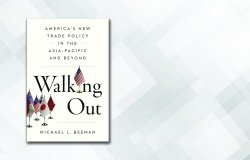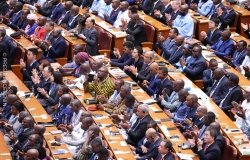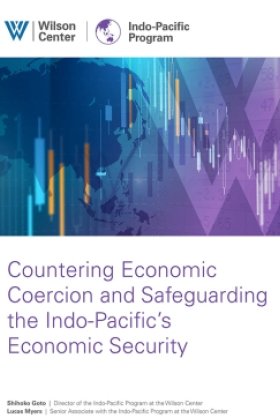Positive Spillover? Impact of the Songhua River Benzene Incident on China' s Environmental Policy
March 2009
On November 13, 2005, an explosion at a petrochemical plant in China's northeastern Jilin Province resulted in the release of 100 tons of toxins into the Songhua River. While the potential environmental impact of the spill was considerable, its significance as a major transboundary and international incident has in recent years leant it a position of particular importance in dialogues on environmental regulation in China. The Songhua River flows from Jilin into Heilongjiang Province where it merges with the Heilong River. The Heilong in turn flows into Russia, where it is known as the Amur River. As the pollution slick from the 2005 spill moved from one administrative region to the next over a period of several weeks, local and national governments moved toward a degree of transparency that is often lacking in the many similar incidents that continue to occur in China. The Songhua spill exposed flaws in China's environmental regulation, including weak local enforcement of environmental laws, poor communication between state agencies and officials, and poor emergency response capacity. Most importantly, the transboundary nature of the incident helped bring it unprecedented levels of international and domestic attention. In the months and years following the Songhua spill, this attention played a significant role in deciding the Chinese government's response. Among the policy consequences of the spill were a revision of the Water Pollution Control Act and an enhanced focus on emergency response.[1] In the short term, the government took on a range of measures, including an extensive legal enforcement campaign in the spring following the spill.[2]
The incident, which was neither a unique nor isolated event, gives us a window on the mechanisms by which environmental regulation and activism continue to provide a working space for China's nascent civil society. The Chinese government's response to the incident may also suggest that environmental protection could provide an ideal platform for improved international coordination in the region.
FERTILE GROUND FOR A VERY PUBLIC DISASTER
The Songhua River spill of 2005 was at first impressive in its own right for its scale and for the apparent danger it posed to the region's communities. The 100 tons of toxic substances released into the river comprised a mix of benzene, nitrobenzene and aniline, with nitrobenzene dominating most samples.[3] At the time of the spill environmental watchdogs noted that the full extent of the contamination would be difficult to assess, one reason being that these chemicals are heavier than water and may collect in pockets at a river's bottom, while the measurements we have come from surface readings.[4] Due to slow response on the part of local officials the concentrations of toxic substances in the Songhua River immediately following the explosion are unknown, but measurements taken outside the city of Harbin in Heilongjiang Province on November 25, the day the pollution slick arrived at the city, show a peak nitrobenzene concentration of 0.581 mg/Liter. This level of nitrobenzene concentration is 33.15 times the level permissible under Chinese law,[5] and 34.18 times the U.S. EPA recommended limit (specifically for nitrobenzene concentration in lakes and streams) of 0.017 mg/L.[6] The minimum toxic dose for humans is not defined, but nitrobenzene poisoning is known to cause severe anemia, cyanosis, and jaundice, while prolonged exposure can cause serious damage to the central nervous system.[7]
Fortunately, recent studies indicate that the long-term effects of the 2005 spill are unlikely to be severe. Given the low carbon content of the river's sediments there is little risk that significant amounts of nitrobenzene will be absorbed, which otherwise could then leach into the region's groundwater.[8] Similarly, computer models created by a team consisting of faculty from Taiwan University and the Harbin Institute of Technology suggest that most of the nitrobenzene from the spill will either volatilize or biodegrade without long-term absorption into suspended particles or sediments.[9]
More important than the long-term impact of the 2005 spill was the common understanding that it was not an isolated event. The Songhua River basin—which in China includes parts of the Inner Mongolia Autonomous Region and Liaoning Province in addition to sizable areas in Jilin and Heilongjiang provinces—is characterized by heavy and outdated industrial development. Long known as the "industrial cradle of China," the northeastern region centered on the Songhua watershed produced much of the country's first steel, machine tools, locomotives and airplanes following the founding of the People's Republic of China in 1949.[10] During the First Five-Year Plan, 58 of the 156 key national projects were set in the northeast region, which is served by the Songhua watershed.[11] The industrial firms established in the 1950s have been hard pressed to stay competitive under China's market reforms, and as a result the region's industries rely on outdated facilities with little or no pollution controls or clean processes.[12] Non-point source pollution in the region also has been monitored for 20 years in the region, and is mostly derived from the over-use of chemical fertilizers, as this is one of China's most productive agricultural regions.[13]
The economic and ecological difficulties faced by the Songhua region drew attention from China's central and regional governments well before the 2005 spill. For example, the Asian Development Bank (ADB) has been involved in regional development projects for 10 years, beginning with the Heilongjiang Water Supply Project in 1999.[14] In 2003 ADB approved funding for the Harbin Water Supply Project, the aim of which was to enable the city of Harbin to take drinking water from the Songhua, which at the time was already too polluted to consume.[15] According to ADB materials, the development of their (still ongoing) projects in the region included extensive policy dialogue with the PRC government.[16]
While central and regional governments worked on long-range development plans meant to address the health of the Songhua, locally the region developed a reputation for lax enforcement of environmental regulations.[17] According to Pacific Environment, a San Francisco-based environmental organization with a long record for supporting environmental activism in Heilongjiang Province, residents of the Songhua watershed claimed that for years prior to the 2005 spill local government officials had been paid by polluters to overlook breeches in environmental regulations. In the weeks following the spill local activists singled out the Harbin Pharmaceutical Group, claiming it had dumped toxins into the Songhua for years while the company's importance in the regional economy led officials not only to overlook the transgressions, but to warn off journalists who wanted to report the story.[18]
Increasing public and government awareness of the Songhua watershed's ill heath peaked with the 2005 benzene spill. By this time pollution in the Songhua watershed was a topic of serious concern both domestically and, through organizations such as ADB and internationally through nearby Russia. Adding to the public impact of the spill was the region's increasingly informed and well-connected populace. Generalized access to extra-governmental sources of information regarding the spill rendered the government's attempted management of public information largely ineffective, adding to the event's impact in the public arena.
FLAWS CAST IN SHARP RELIEF
Much of the notoriety of the 2005 Songhua spill derives from the flawed response capability exhibited by central and regional state authorities. On November 26, representatives from China's State Environmental Protection Agency (SEPA) visited both the UN Environmental Programme (UNEP) in Nairobi and the United Nations offices in Beijing to provide extensive data on the Songhua spill, after which SEPA continued to send regular updates to the United Nations.[19] Although a decisive move on the part of the Chinese state, it approached the United Nations only after the pollution slick had reached Harbin, a full two weeks following the initial explosion in Jilin Province. While the central government went public largely because it could no longer keep information on the incident from its own citizens, it is perhaps safe to assume that this was the longest the Chinese government could wait without risking confrontation with Russia, whose border lay downriver.
Underlying China's delayed response at the international level was an almost paralyzing confusion at local and domestic levels. In the immediate aftermath of the explosion on November 13, factory officials denied that pollutants had entered the Songhua as a result.[20] It was five days before SEPA issued emergency monitoring instructions to its provincial counterpart, the Heilongjiang Province Environmental Protection Bureau (EPB).[21] During those five days it appears that factory officials together with local government officials attempted to manage the spill themselves without notifying Beijing, going so far as to drain reservoir water into the Songhua in an attempt to dilute the contaminants.[22] Even after the central government intervened on November 18, it failed to notify the general public of the danger until the slick reached Harbin.[23] In the intervening period, public rumor regarding an undefined public emergency proliferated. Several days before the spill reached Harbin, city officials shut down municipal water services, citing a need to repair the system's facilities.[24] Few were reassured and on November 25, the government was forced to make information on the spill available to the public in order to discount the wilder rumors, which included earthquake warnings.[25]
Following the central government's announcement, the domestic media was filled with material regarding the spill. Many of these articles traced the chain of responsibility and cover-up leading back to the explosion, in the process implicating high-ranking officials first in Jilin and later in Harbin.[26] At this time the international media and international environmental groups also became closely involved, following the domestic media's lead in focusing on the dangerous lack of public information surrounding the spill. Even the UNEP team invited to help evaluate the situation on the Songhua in December 2005, whose initial Field Report generally approves of the Chinese government's response to the disaster, noted that the lack of public information management posed an avoidable danger, and indicated a lack of centralized emergency response procedures.[27] The report pointedly recommends that the Chinese government work to alleviate this weakness in its administrative network.[28]
IMPACT ON MAKING AND IMPLEMENTATION OF ENVIRONMENTAL POLICY
Of the flaws in China's environmental regulation exposed by the Songhua spill, that which was most emphasized in domestic and international media was the government's lack of coherent emergency response. At the time of the spill, the enforcement of environmental protections fell to regional EPBs, which operated independently from SEPA.[29] Rather than report directly to SEPA, local EPB's operated under the authority of their local provincial governments. As these local governments tend to focus on economic development, in most cases local EPB's were not able to effectively enforce the central government's policies.[30] The disconnect between policymaking in the central government and local enforcement was widely recognized at the time as being a major source of confusion surrounding the Songhua spill, and correspondingly of the failure to organize an effective, population-wide response.[31]
Actions undertaken by the Chinese government following the 2005 spill indicate that lawmakers moved quickly to address the problem of administrative disconnect. In this effort the government was aided by the fact that it had already begun projects intended to narrow the gap between national and local governments, specifically in the area of environmental regulation. For example, in 2002 Beijing began to establish Regional Supervision Centers (RSCs) that answered directly to SEPA instead of local governments.[32] Following the Songhua incident, the process of establishing the local EPBs was further expedited and prioritized, and both ADB and the World Bank are currently involved in projects helping the establishment of additional RSCs. At present the RSCs, which include a major center in Chongqing, have met with limited success,[33] but they represent an important step towards a clear chain of accountability in the process of environmental protection, which in itself promotes government transparency.
More recently, SEPA has gained ministerial status in the Chinese government. Now known as the Ministry of Environmental Protection (MEP), SEPA was reorganized in March 2008 to greatly strengthen connections between regional EPBs and the new central ministry.[34] The EPBs are still largely beholden to local governments, but with MEP comes a higher level of authority and, more concrete still, an administrative structure that could be adapted to incorporate the EPBs in a more vertical structure like that employed by China's State Tax Bureau.[35] Whether or how to effect such a change is a topic of debate.[36] Wen Bo of Pacific Environment suggests that the raising of SEPA to ministerial status owes more to a growing official and public recognition of China's environmental crisis, and less to the Songhua River spill in particular. He rightly points out that similar incidents occur in China on a weekly basis, and that the Songhua spill is unique mostly in the amount of press it received.[37] However, Lida Tan of the U.S. EPA notes that the reorganization of SEPA, while only announced in 2008, would have required extensive preparation beginning much earlier, perhaps placing the move's beginnings during the official fallout over the Songhua spill in early 2006.[38]
NEW MEASURES OF ACCOUNTABILITY
The November 2005 Songhua spill marks a moment of rare open dialogue between China's domestic and international media, state and local government officials, and a more general assortment of voices speaking through Internet forums, cell phones, and university bulletin boards.[39] As measures intended to control the spread and release of information failed, the government proved remarkably deft in responding to public criticism. Once opened, lines of communication with international and domestic environmental groups and media outlets remained so, receiving regular updates regarding the spill and efforts to control its impact. In addition to UNEP, the Chinese invited Russian scientific teams to take part in measurements and further work during the event's clean-up phase.[40] In large cities affected by the spill, such as Harbin, the government shipped in emergency supplies of bottled water, and in some cases used fire trucks to supply local towns.[41]
Concurrently, old measures of accountability played out for the public eye. At the beginning of December in 2005 Xie Zhenhua, chief of SEPA since 1993, resigned in disgrace.[42] It was fairly well understood at the time that he had inherited the crisis from the regional officials who had unsuccessfully attempted a cover-up.[43] Shortly thereafter, in early 2006, the mayor of Jilin City committed suicide.
Such public displays of guilt and accountability have a long history in modern China, but in this case public involvement in events surrounding the spill was extensive, thereby painting high-level casualties in an almost anachronistic light. Not only did reactions among local citizens and domestic media help to inform government response, but in essence the public discourse carried on, as policymakers passed the Water Pollution Control Act and focused on emergency response.
Drawing a connection between legislation and public dialogue following the 2005 spill, it may be that part of the promise of environmental law in China is its potential as a field where the state can experiment with new kinds of accountability, even leading to a measure of extended transparency.
Nat Green is a research intern with the Social Science Research Council's China Environment and Health Initiative. He can be reached at greennat@gmail.com.
The author would like to thank Linden Ellis of the China Environment Forum, Wen Bo of Pacific Environment, Lida Tan of the U.S. EPA, and Tseming Yang of Vermont Law School for their contributions.
[1] Tseming Yang (private correspondence 2/25/2009).
[2] Tseming Yang (private correspondence 2/25/2009).
[3] UNEP. (2005, December). The Songhua River Spill: Field Mission Report. Nairobi: United Nations Environmental Programme.
[4] See Pacific Environment. (2005, November). "Harbin Crisis Was Years in the Making." [Online]. Available.
[5] UNEP. (2005, December). Field Mission Report.
[6] ATSDR. (1999). ToxFaqs: Nitrobenzene. [Online]. Available.
[7] Risk Assessment Information System. (1997). Toxicity Profiles. [Online]. Available.
[8] LIU et al. (2008, February). Characterization of the Songhua River sediments and evaluation of their adsorbtion behavior for nitrobenzene. Journal of Environmental Sciences.
[9] REN et al. (2007). Modeling the nitrobenzene in the Songhua River. Water Science and Technology: water supply 7(2).
[10] ADB. (2005, September). Technical Assistance Consultant's Report: People's Republic of China: Songhua River Basin Water Quality and Pollution Control Management – Summary Report. Manila: Asian Development Bank.
[11] ADB. (2005, September). Technical Assistance Consultant's Report: People's Republic of China: Songhua River Basin Water Quality and Pollution Control Management – Summary Report. Manila: Asian Development Bank.
[12] Ibid.
[13] Ibid.
[14] See ADB. (2008). "Urban Innovations: ADB's Contribution to Pollution Control in the Songhua River Basin." [Online]. Available.
[15] Ibid.
[16] Ibid.
[17] Pacific Environment. (2005, November). "Harbin Crisis was Years in the Making." [Online].
[18] Ibid.
[19] UNEP. (2005, December). Field Mission Report.
[20] Jim Yardley. (2005, November 26). "Spill in China Brings Danger, and Cover-Up." New York Times. [Online]. Available.
[21] UNEP. (2005, December). Field Mission Report. 7.
[22] Jim Yardley. (2005). "Spill in China."
[23] UNEP. (2005, December). Field Mission Report.
[24] Ibid.
[25] Ibid.
[26] Ibid.
[27] UNEP.
[28] UNEP. 7, 11.
[29] Wen Bo. (Private correspondence 2/2009).
UNEP. 7.
[30] Wen Bo. (2009, Feb.).
[31] See Ching-Ching Ni. (2005, Dec. 4). "China Fires Environment Chief as It Deals with Tainted River Fallout." L.A. Times;
"Jilin authorities slammed for ‘poor work'." (2005, December 2). People's Daily.
[32] Lida Tan. (Private correspondence, 12/2008)
[33] Wen Bo. (2009).
[34] Wen Bo. (2009).
[35] Ibid.
[36] Ibid.
[37] Ibid.
[38] Lida Tan. (2008).
[39] Ching-Ching Ni. (2005); See also "China sacks environmental chief following major river pollution." (2005, December 3). People's Daily.
[40] UNEP. (2005, December). Field Mission Report.
[41] "More cities avoid Songhua water." (2005, December 3). Taipei Times.
[42] In 2006, Xie Zhenhua found a new and more powerful position as deputy head of the National Development and Reform Commission, overseeing environmental protection and energy conservation.
[43] Ching-Ching Ni. (2005); See also "China sacks environmental chief following major river pollution." (2005, December 3). People's Daily.
About the Author
Nat Green
Read More
China Environment Forum
Since 1997, the China Environment Forum's mission has been to forge US-China cooperation on energy, environment, and sustainable development challenges. We play a unique nonpartisan role in creating multi-stakeholder dialogues around these issues. Read more











